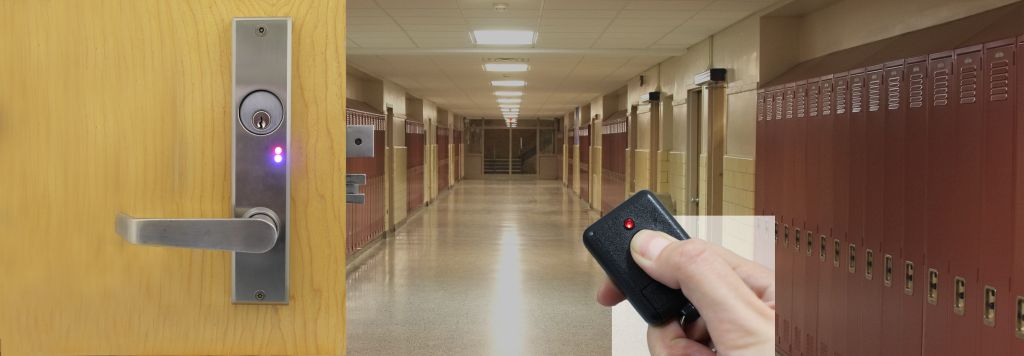By Mark J. Berger
Standards are our way of selecting products that we know will meet our needs as well as relevant codes and safety regulations. Standards must evolve to meet emerging needs. Classroom lock standards have evolved over the last 100 years, but there haven’t been too many changes in the last 25 years.
With the advent of security protocols to protect students, teachers and staff in the event of a life-threatening assailant incident in a school, all the elements in a classroom that play a part must be evaluated. You will see recommendations for security film and shades or blinds to cover vision lites to support the safe haven in a classroom. Door locks must also play a part in keeping everyone safe in the room.
The State of Connecticut’s Sandy Hook report echoed what the Department of Homeland Security’s Safe School Design Primer recommended in 2012: A classroom door, locked without entering the hallway, is the first line of defense for those in the classroom. Speedily locking the door by a simple method such as a pushbutton was the first DHS recommendation. Ensuring that anyone can lock the door and eliminating the need for a key or special credential is paramount in any selection of “Lockdown” products.
On this 5th anniversary of the Sandy Hook tragedy, we should recognize that standards agencies have been busy working to ensure that codes reflect the lessons learned. National codes are the result of meetings, proposals, discussion, debate, revision and voting. They are not developed in a haphazard manner, and while municipalities, product producers, industry trade groups and others can forcefully advocate for a position, ultimately the votes to change a code reside with the code officials and other related professionals who participate in the code-making process.
Products reacting to the horrific events in school started to emerge in 2013 and have proliferated over the years. School officials who want to create a safe environment are flooded with products for use on classroom doors, as well as camera systems, notification systems, shot detectors and more. It is very difficult trying to mine the landscape of school locking solutions.
Sales pitches were created that used fear as a motivation and glossed over life safety in the process. There are online videos for some of these products which depict assailants and methods found in sophisticated and frightening assaults you would see in a movie, and are not reflective of what has happened in the school environment. Others depicted well-intentioned products that clearly violated life safety standards.
Let’s take a moment to talk about the door. The door is a portal to a space and can provide restrictions to bar entry (commonly called “locking”) but in a classroom must always provide unobstructed exiting (you’ll hear the term “free egress”). These two elements must always be considered when reviewing door locking products. These two elements have always been part of every school locking code. There’s a third factor, access by school staff and first responders, that has now been recognized as an important component and been added to code language.
While access might seem obvious and there wouldn’t be a need for code language, the proliferation of solutions that, when applied to a door bar entry by a key holder, has created a need to spell out exactly what a door lock or device applied to a door cannot do.
Single motion exiting is a hallmark of every life-safety code. Lessons learned from fire deaths over the past 100 years, including such tragedies as the Triangle Shirtwaist Co. fire in New York, The Iriquois theatre fire in Chicago, and the Cocoanut Grove night club fire in Boston all point to the need to exit quickly and without special knowledge. Exiting quickly led to the creation of panic bars or exit devices for places of public assembly. We all are aware that there cannot be anything else (deadbolt lock, slide bolt or other item) applied to a door in addition to the exit device.
It’s a little trickier for other doors where lever handles are used. We are accustomed to a secondary deadbolt in our homes, but operating a deadbolt, sliding back a slide bolt, removing a 2×4 from brackets across the door all require what is referred to as “special knowledge” and violate codes. That’s because at the very minimum two actions would be required to exit. Smaller spaces, like classrooms, typically do not require exit devices, but the single motion egress rules are always in place. Any student or teacher in the room must be able to approach the door and exit by lowering the lever and pulling or pushing the door.
Going back to the products created to secure students in a classroom and prevent a would-be assailant from entering the classroom, all those devices which you would add onto a door violate the single motion egress code. Furthermore, most of them prevent entry by first responders. The IBC classroom door locking code has been updated to emphasize that single motion exiting remains a requirement for classroom doors. New language has been added to ensure that doors must always be capable of entry by a key or credential (like an access control card). There aren’t any carve outs or exceptions – safety is paramount and security must be achieved without sacrificing safety.
Responsible manufacturers who understand the code have developed products that respect the existing codes and are therefore positioned to meet the code’s updated language. That’s because the code’s wording hasn’t changed to lessen safety – it maintains everything we’ve known and codifies a subject (entry) that had not been spelled out.
Schools can choose from a variety of classroom locks that meet the code language as well as the recommendations of the Sandy Hook commission and DHS Primer. These products work with existing door preparations and do not require training anyone in how to exit a door. Options include electric lockdown, instant deadbolt locking for greater protection and key or electric unlocking. Newer solutions include adaptors for exit devices to instantly lockdown doors where they are applied.
One further note of caution to anyone considering a non-compliant product. While the motivation to bring these products into a classroom is certainly to protect students and allow them to secure their safe haven, we must recognize an even greater risk these products present. If they are misapplied and used to bolt or barricade a door, a bully or other person could not only trap someone in a classroom and prevent their escape, but a teacher or first responder would not be able to enter. This unintended consequence could tragically result in a loss of life.
The code revision will help guide the decision-making process for school districts as the rules are now in place. While these revisions are part of the 2018 codes and have to be adopted by each state or municipality, knowing what the code entails should guide all specifications and purchases.
Mark J. Berger is president, Securitech Group, Inc., www.securitech.com. He is also Chair, Builders Hardware Manufacturers Association Codes, Government and Industry Affairs Committee.






